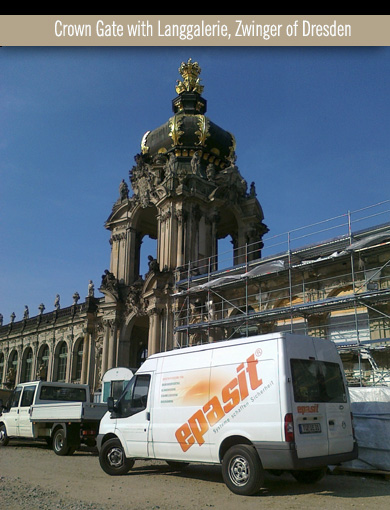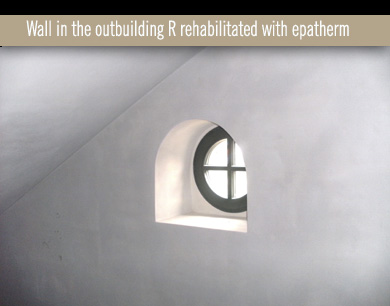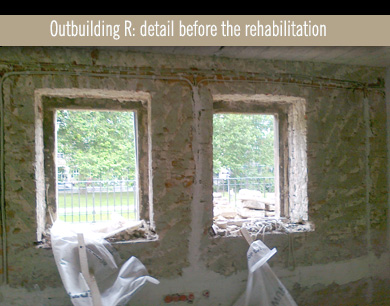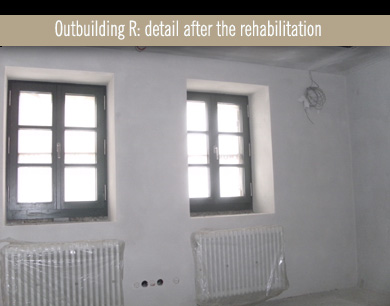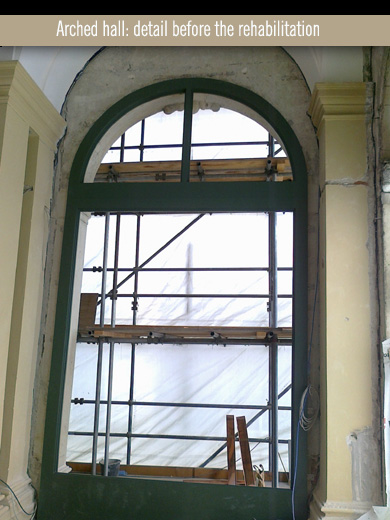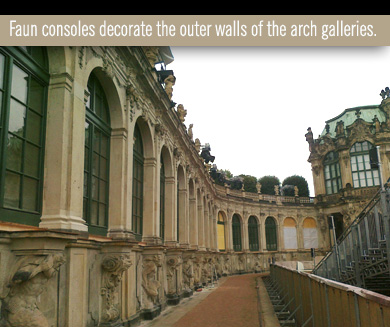|
|
|
Zwinger
of Dresden:
Rehabilitation and insulation of the Royal Cabinet of Mathematical
and Physical Instruments

The Zwinger belongs to Germany's
most well-known Baroque monuments. It accomodates art collections
and museums and is presently fundamentally rehabilitated. In the
Royal Cabinet of Mathematical and Physical Instruments the responsible
persons decided to apply calcium silicate boards as an interior
insulation. Since 1728, the Cabinet accomodates an exhibition of
precise mechanical instruments and the reopening is planned for
spring 2013.
The Staatsbetrieb Sächsisches Immobilien- und Baumanagement
(SIB) opted for an energy-efficient rehabilitation with calcium
silicate boards for the following main reasons: Energy saving and
avoidance of mould formation. As everybody knows, sandstone has
a low insulating value and by means of insulating the sandstone
building, the future energy costs shall be reduced. Besides, the
condensation on the sandstone walls also hold the risk of mould
growth. To avoid damages due to moisture in the long term, a pure
mineral building material system will be used. In some sections
of the Royal Cabinet of Mathematical and Physical Instruments as
well as in the neighbouring utility rooms more than 450 m2 of epatherm
boards with an average thickness of 50 mm have been consumed.
Mounting of the interior insulation system

Firstly, the employees of the Augsburg C. Bau
GmbH, Dresden, levelled the existing unevenness of the walls with
the lime cast 'mpm1'. Secondly, the all over primary coated calcium
silicate boards were mounted to the inner surfaces of the outer
walls and to the ceilings by using the appropriate system adhesive.
The careful and high-quality carrying out of the work could be guaranteed
by the epasit service on site. As a finish, the inside filler 'multi-eti',
which is a double-ply filler with embedded system reinforcement
lattice, was used. Thus, the original appearance of the plastered
surfaces could be maintained as desired.
Rehabilitation of the
Cabinet

The Royal Cabinet of Mathematical and Physical Instruments is one
of the four corner pavilions of the Zwinger, which are connected
by arch galleries. Faun consoles decorate the facades of the arch
galleries in the area of the basement. Between the Cabinet and the
remarkable 'Crown Gate' lies the gallery 'Langgalerie' O. In the
building sections 'Bogengalerie' K, 'Grottensaal', 'Langgalerie'
O and Pavilion F, the inner surface of the outer walls of the wall
arches above the windows, as well as the reveals of the big windows
made of wood-profiles, have been rehabilitated in an energy-efficient
way. For the semicircular arch of the windows an exact cut was necessary.
Between the boards and the window frames the masons
mounted an open-pored sealing tape, thus, damages caused by moisture
and the so-called 'fogging' effect, are avoided in the long term.
Despite filigree cuts some areas decorated with stucco elements
could not be fitted completely with boards. As agreed with the supervision
of works, the junctions have been levelled by the masons with climatic
plaster.
Rehabilitation of the utility
rooms

The 'outbuilding R' represents the neighbouring
utility rooms from the 1920s, which were built from a mixed brickwork
of a thickness of 60 cm. The walls were rehabilitated in the same
way like the Cabinet, the ailing plaster was removed, the walls
newly plastered and insulated with calcium silicate boards. The
boards apply to the standard specifications of the fire classification
A1 and are thus non flammable. In the ceiling area, the boards have
been glued and plugged; because of the fire regulations, the masons
used insulation anchors in stainless steel. To avoid thermal bridges,
the dowel-holes have been closed with cut out of epatherm boards,
the so-called 'energy-efficient encapsulations'. The ceiling partly
consisted of uneven concrete boards, therefore the masons first
created a level surface with the help of a plaster reinforcing mesh
made out of stainless steel and then plastered it with lime cement
facing.
Precise mechanical miracles

Monarchs interested in technique collected
for centuries mathematical and physical instruments as well as mechanical
mechanisms of musical boxes. Because of this, as a part of the royal
Saxon art collections, the Royal Cabinet of Mathematical and Physical
Instruments was created in the Zwinger . The show-pieces include
the astronomical clock or the world clock. The astronomical clock
was constructed in the 1950s and shows, according to the time, the
position of the planets, Sun, Moon, Mercury, Venus, Mars, Jupiter
and Saturn. The world clock developed around 1690 by Andreas Gärtner,
shows with the help of the gravity, the time of 365 places around
the world . After the rehabilitation, these and many other 'miracles'
of the precision mechanics can presumably be visited from April
2013 onwards.
Good for structure and climate

The epatherm system is authorized by the legal
authority for construction and is frequently applied in the field
of preservation of monuments. Up to now, the epasit GmbH was the
only producer willing to allow its complete indoor climate board
system to be analyzed according to the strict requirements of the
Sentinel-Haus Institut and it fulfils these without restrictions:
All components have been classified as components which show no
risks for health and no allergen risks.
Presse contact:
epasit GmbH Spezialbaustoffe
Peggy Wandel
Sandweg 12 - 14, D-72119 Ammerbuch-Altingen,
Tel +49 (0) 7032 2015-0, Fax +49 (0) 7032 2015-21
e-Mail: presse@epasit.de
|
|
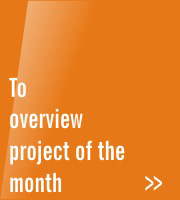
WEITERE OBJEKTE:

Gymnasium zu Bratislava

Burg zu Bratislava

Trinkwasserbehälter
Lindau

Altes Rathaus
Bonn

Stadtgymnasium
Helsinki
 Jugendstilvilla
in Aalen
Jugendstilvilla
in Aalen
 Waldseer
Hof Markdorf
Waldseer
Hof Markdorf
 Therme
Rügen
Therme
Rügen

Schimmelalarm im
Badezimmer

Diakonie-Gebäude
Witten

Leonhardskirche English
>>

Deutscher Kaiser
English
>>

Wilhelma Stuttgart English
>>

Trinkwasserbehälter English
>>

Hafenviertel Tallinn English
>>

EZB Frankfurt English
>>

Zwinger Dresden English
>>

TU-Krakau English
>>

Brunnen Maulbronn English
>>

Jurahaus English
>>

Contact
us

Do you have questions and need
a personal contact?
Phone
+49 (0)7032
- 20 15-0
Project management

Holger Trepte
IIf you have further questions regarding this object or a similar
problem, please contact us.
Contact us

e-Mail:
holger.trepte@epasit.de
Phone
+49(0)35022-917641
|
